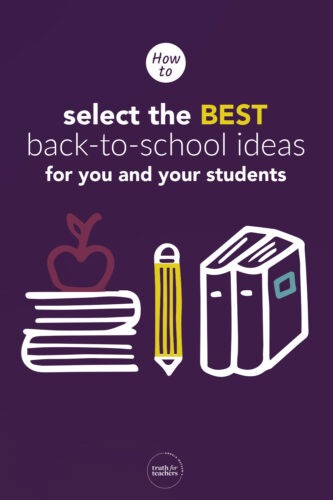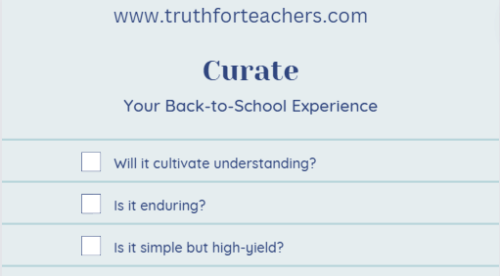There are so many different ways to start the school year–which ones are right for YOU?
Those first days feel so important! First impressions matter! Being overwhelmed and trying to do all the things in those first few days is definitely not on brand for Truth for Teachers. Check out this guide to curate a focused and enjoyable back-to-school plan.
Grab your notebook and pen (or however you like to plan), and let’s get started.

1. Identify what you want students to know, understand, and do
Know, Understand, and Do (or KUDs) are part of the Understanding by Design framework coined by Jay McTighe and Grant Wiggins. This is a method of backwards planning used for academic units that can be applied in miniature form to the first days of school. Instead of planning backwards from a unit’s final assessment, you’re planning backwards from what you want the class to look and feel like for the year.
In the “know” area, write any absolute information students need to know early. This is about making the “hidden curriculum” clear for all students. This could be:
- Key language you use to cue routines and procedures
- Policies and rules
- Locations of different items
In the “understand” area, write the “universal truths” that will guide how the classroom operates. This is about establishing school and classroom culture intentionally. These could be:
- Identity statements that your whole school uses (e.g. “I am responsible.”).
- Value statements that drive your class (e.g. “We co-create this class everyday.”).
In the “do” area, write things you want students to do in the very first days. This is about establishing the early habits that will become the bedrock of the class. These could be:
- Routines and procedures
- Classroom community builders (like classroom meetings)
- “Light” academic habits (e.g. reading, asking questions, persisting in the face of a challenge, etc.)

Caption: This is the first draft of my list. I added quite a bit to it later on, but I wanted you to have a visual for the process.
2, Identify what you want to know, understand, and do
Once you’ve envisioned what you want students to know, understand, and do, you need to create a similar list for yourself. We don’t plan enough for making sure our needs are met early and often in the classroom so that we can do our best work.
In the “know” category, you may list certain student information, for example:
- Name pronunciation
- Interests
- Ideal conditions for learning
- Motivational style
In the “understand” category, you may list the beliefs you need to hold to have a great start of the year, for example
- I create what I expect.
- There is plenty of time.
- We are here to learn.
In the “do” category, you may list the actions you want to take in those first days. For example:
- Talking with each student
- Observations you want to make
- Choosing carefully how you speak to individual students and the class
- When and how you offer help
- When and how you offer praise
- Self-care activities (this and other activities could be during or around the school day, but they are still important to schedule for yourself).
3. Brainstorm and envision
This part is pure idea generation. List as many different ways as you can think of to accomplish your KUDs for students and for yourself. You can organize this by going line-by-line or just brain-dumping in a long list. There won’t necessarily be one activity for each item on your list. You will start to see ways in which several items cluster together. The important thing is to not stop at one idea. Generate lots of ideas.
This is a place where some teachers may turn to the internet for ideas. I like Tim Ferriss’ encouragement of an information diet–being selective about how much information you take in. I try to stick with what I come up with, just because it’s overwhelming to add ideas from all over the internet too. Sometimes I will search a specific favorite teacher website, which gives me a few high-quality ideas without sending me down the rabbit hole. The point is to have some options, not go on the hunt for the very perfect back-to-school sequence. School is imperfect. Best to accept it from day one.

4. Curate
From this giant list, it’s time to curate. Not everything from the giant list can or should be included. There are several questions I consider in the curation process.
- Will it cultivate understanding? The knowing and the doing are pretty easy to get in a variety of ways, but featuring an understanding is deep, intentional work that is easily lost in service of knowing and doing. Build around the understanding first.
- Is it enduring? I want students creating enduring products or prior knowledge experiences that we can return to throughout the year. I want mileage out of those first few days, and bonus points if I can pull the activities/products into a welcome packet for late-joiners to the class or into a back-to-school presentation for families.
- Is it simple but high-yield? Gone are my days of elaborate pre-cutting and crafting to prepare a one-day activity before students arrive. Gone are my days of complicated directions (their brains–and mine–are still in summer mode). I am here for simple, non-threatening human connection from day one. I am here for finding out so much more by watching and listening. (For more ideas, check out the Ultimate Guide for Authentically Creating a Secondary Classroom Where Students Feel Safe, Connected, and Whole)

5. Schedule
Decide how many days you want to devote to “back-to-school” before starting your academic curriculum. This may depend on your calendar, the age of your students, and/or the activities you want to do. We start with a three-day week, and I teach high school, so I will start with those three days. We will revisit and add throughout the school year, so I am not trying to jam in every single thing those first three days. Most routines I teach naturally the first time the need arises. For more information on this, I recommend the 40 Hour Teacher Workweek, which was my best teacher for scheduling all the routines I need to teach.
How do you want back-to-school to feel?
The choice really is yours. As I said earlier, trust your instincts about the activities you include, but if you are looking for some inspiration, you can read what came from my planning process at Get Back to School with 8 Easy and Fun Activities for High School.

Jennifer Brinkmeyer
7th-12th Grade ELA
Sign up to get new Truth for Teachers articles in your inbox
OR

Join our
community
of educators
If you are a teacher who is interested in contributing to the Truth for Teachers website, please click here for more information.
















